ICT705 Data Integration: Electronic Health Records System Analysis
VerifiedAdded on 2024/05/23
|19
|3489
|237
Report
AI Summary
This report provides an analysis of Electronic Health Records (EHR) and data and system integration within the healthcare industry. It addresses the limitations of traditional paper-based systems and how EHR implementation can improve efficiency, cost, safety, and the quality of medical care. The report proposes a cloud-based EHR architecture, detailing its components such as the Central Database Server, Network Interface, and Authentication Server, and discusses security and privacy controls. It also explores various domains where EHR is useful, including primary care, hospitals, and research labs, highlighting the benefits of the proposed system, such as data privacy, better clinical care, and improved medical record management. The report further discusses information management, integration of structured and unstructured data, and possible solutions for EHR standards.

Data and system integration
Task1
Task1
Paraphrase This Document
Need a fresh take? Get an instant paraphrase of this document with our AI Paraphraser
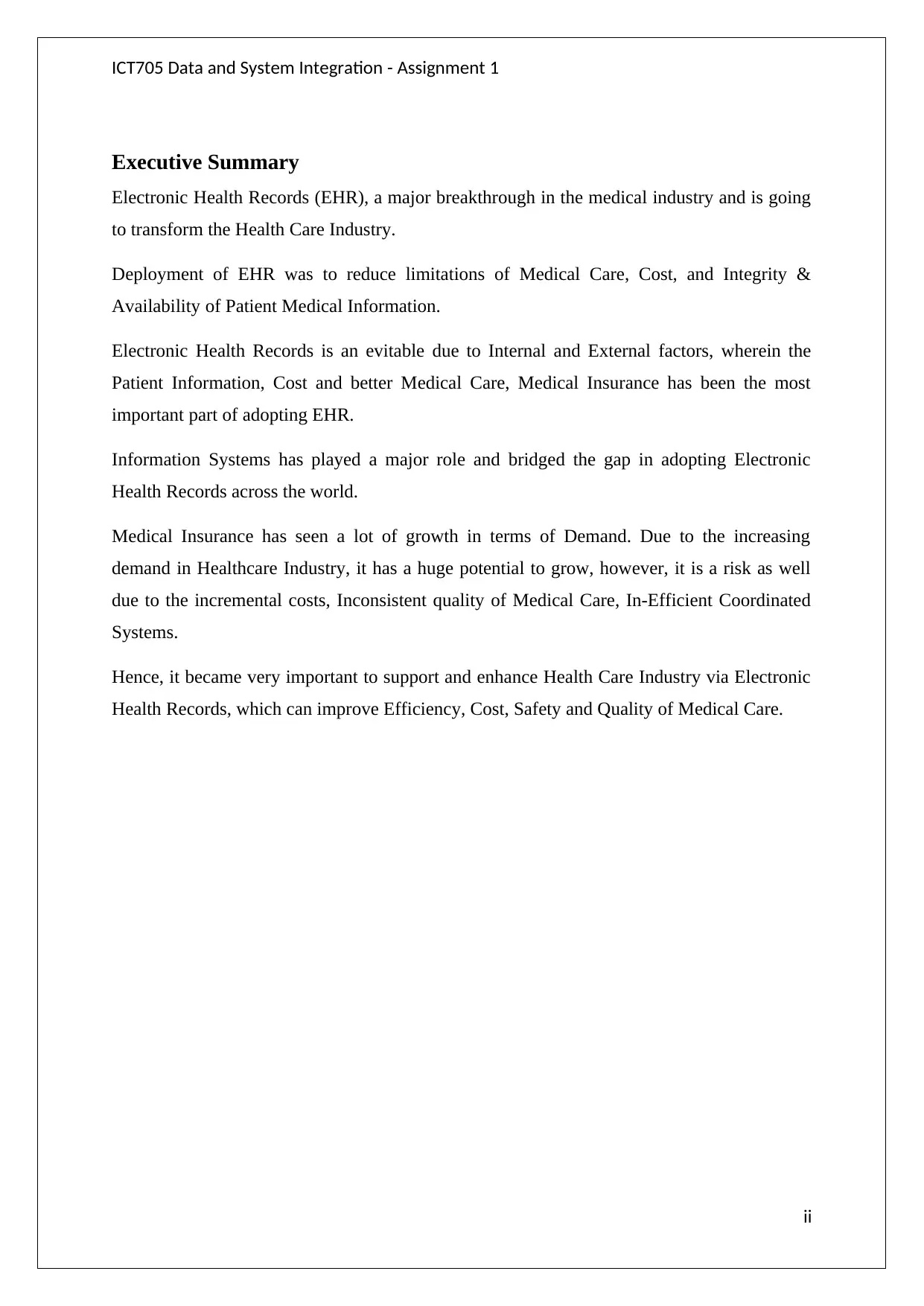
ICT705 Data and System Integration - Assignment 1
Executive Summary
Electronic Health Records (EHR), a major breakthrough in the medical industry and is going
to transform the Health Care Industry.
Deployment of EHR was to reduce limitations of Medical Care, Cost, and Integrity &
Availability of Patient Medical Information.
Electronic Health Records is an evitable due to Internal and External factors, wherein the
Patient Information, Cost and better Medical Care, Medical Insurance has been the most
important part of adopting EHR.
Information Systems has played a major role and bridged the gap in adopting Electronic
Health Records across the world.
Medical Insurance has seen a lot of growth in terms of Demand. Due to the increasing
demand in Healthcare Industry, it has a huge potential to grow, however, it is a risk as well
due to the incremental costs, Inconsistent quality of Medical Care, In-Efficient Coordinated
Systems.
Hence, it became very important to support and enhance Health Care Industry via Electronic
Health Records, which can improve Efficiency, Cost, Safety and Quality of Medical Care.
ii
Executive Summary
Electronic Health Records (EHR), a major breakthrough in the medical industry and is going
to transform the Health Care Industry.
Deployment of EHR was to reduce limitations of Medical Care, Cost, and Integrity &
Availability of Patient Medical Information.
Electronic Health Records is an evitable due to Internal and External factors, wherein the
Patient Information, Cost and better Medical Care, Medical Insurance has been the most
important part of adopting EHR.
Information Systems has played a major role and bridged the gap in adopting Electronic
Health Records across the world.
Medical Insurance has seen a lot of growth in terms of Demand. Due to the increasing
demand in Healthcare Industry, it has a huge potential to grow, however, it is a risk as well
due to the incremental costs, Inconsistent quality of Medical Care, In-Efficient Coordinated
Systems.
Hence, it became very important to support and enhance Health Care Industry via Electronic
Health Records, which can improve Efficiency, Cost, Safety and Quality of Medical Care.
ii

ICT705 Data and System Integration - Assignment 1
Table of Contents
Executive Summary...................................................................................................................ii
Introduction................................................................................................................................1
Enterprise Information Architecture..........................................................................................2
EHR Implementation View........................................................................................................7
Various Domains where EHR has been Useful.........................................................................9
Information Management and Integration...............................................................................11
Conclusion................................................................................................................................13
Recommendations....................................................................................................................14
Bibliography.............................................................................................................................15
References................................................................................................................................16
iii
Table of Contents
Executive Summary...................................................................................................................ii
Introduction................................................................................................................................1
Enterprise Information Architecture..........................................................................................2
EHR Implementation View........................................................................................................7
Various Domains where EHR has been Useful.........................................................................9
Information Management and Integration...............................................................................11
Conclusion................................................................................................................................13
Recommendations....................................................................................................................14
Bibliography.............................................................................................................................15
References................................................................................................................................16
iii
⊘ This is a preview!⊘
Do you want full access?
Subscribe today to unlock all pages.

Trusted by 1+ million students worldwide
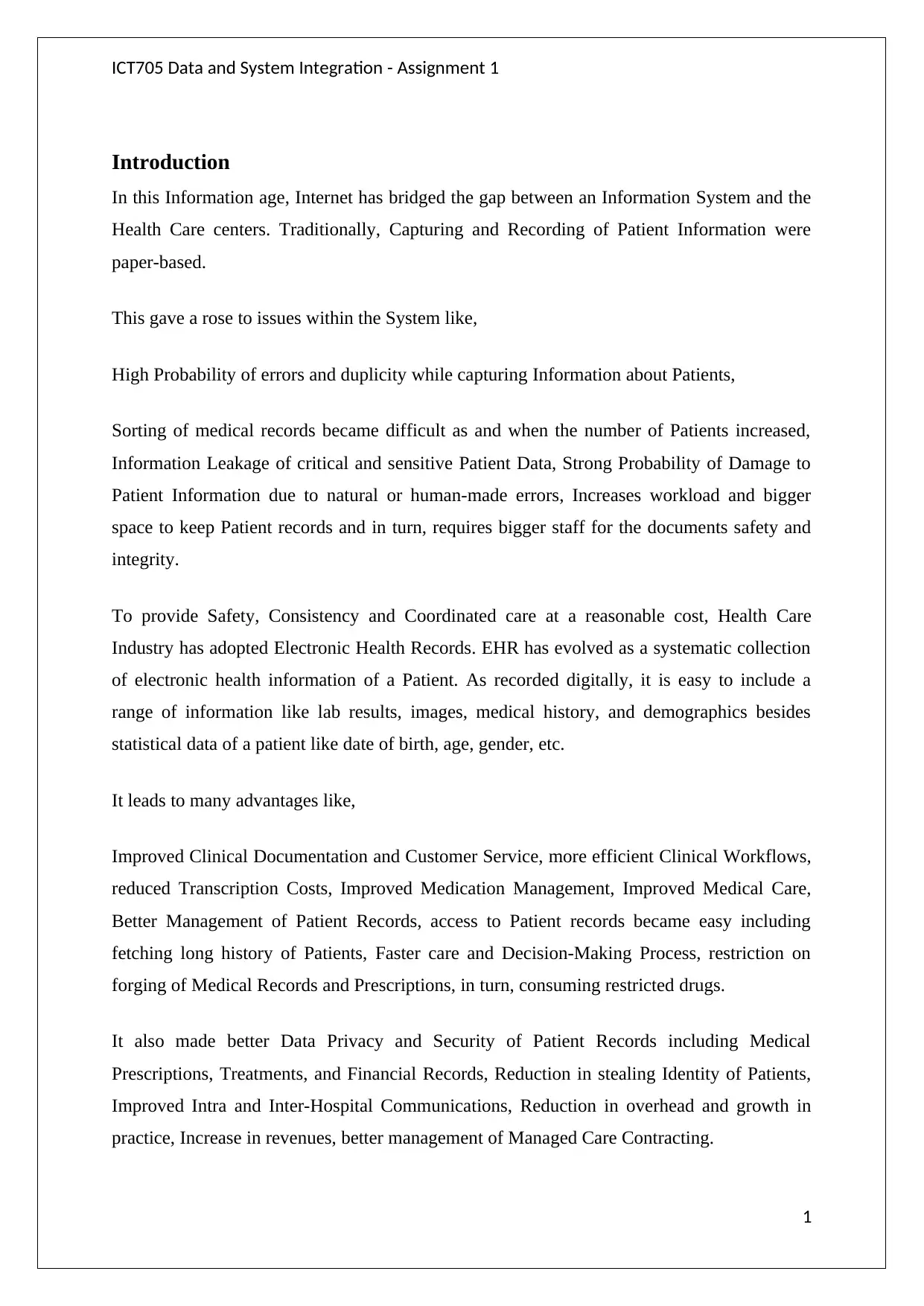
ICT705 Data and System Integration - Assignment 1
Introduction
In this Information age, Internet has bridged the gap between an Information System and the
Health Care centers. Traditionally, Capturing and Recording of Patient Information were
paper-based.
This gave a rose to issues within the System like,
High Probability of errors and duplicity while capturing Information about Patients,
Sorting of medical records became difficult as and when the number of Patients increased,
Information Leakage of critical and sensitive Patient Data, Strong Probability of Damage to
Patient Information due to natural or human-made errors, Increases workload and bigger
space to keep Patient records and in turn, requires bigger staff for the documents safety and
integrity.
To provide Safety, Consistency and Coordinated care at a reasonable cost, Health Care
Industry has adopted Electronic Health Records. EHR has evolved as a systematic collection
of electronic health information of a Patient. As recorded digitally, it is easy to include a
range of information like lab results, images, medical history, and demographics besides
statistical data of a patient like date of birth, age, gender, etc.
It leads to many advantages like,
Improved Clinical Documentation and Customer Service, more efficient Clinical Workflows,
reduced Transcription Costs, Improved Medication Management, Improved Medical Care,
Better Management of Patient Records, access to Patient records became easy including
fetching long history of Patients, Faster care and Decision-Making Process, restriction on
forging of Medical Records and Prescriptions, in turn, consuming restricted drugs.
It also made better Data Privacy and Security of Patient Records including Medical
Prescriptions, Treatments, and Financial Records, Reduction in stealing Identity of Patients,
Improved Intra and Inter-Hospital Communications, Reduction in overhead and growth in
practice, Increase in revenues, better management of Managed Care Contracting.
1
Introduction
In this Information age, Internet has bridged the gap between an Information System and the
Health Care centers. Traditionally, Capturing and Recording of Patient Information were
paper-based.
This gave a rose to issues within the System like,
High Probability of errors and duplicity while capturing Information about Patients,
Sorting of medical records became difficult as and when the number of Patients increased,
Information Leakage of critical and sensitive Patient Data, Strong Probability of Damage to
Patient Information due to natural or human-made errors, Increases workload and bigger
space to keep Patient records and in turn, requires bigger staff for the documents safety and
integrity.
To provide Safety, Consistency and Coordinated care at a reasonable cost, Health Care
Industry has adopted Electronic Health Records. EHR has evolved as a systematic collection
of electronic health information of a Patient. As recorded digitally, it is easy to include a
range of information like lab results, images, medical history, and demographics besides
statistical data of a patient like date of birth, age, gender, etc.
It leads to many advantages like,
Improved Clinical Documentation and Customer Service, more efficient Clinical Workflows,
reduced Transcription Costs, Improved Medication Management, Improved Medical Care,
Better Management of Patient Records, access to Patient records became easy including
fetching long history of Patients, Faster care and Decision-Making Process, restriction on
forging of Medical Records and Prescriptions, in turn, consuming restricted drugs.
It also made better Data Privacy and Security of Patient Records including Medical
Prescriptions, Treatments, and Financial Records, Reduction in stealing Identity of Patients,
Improved Intra and Inter-Hospital Communications, Reduction in overhead and growth in
practice, Increase in revenues, better management of Managed Care Contracting.
1
Paraphrase This Document
Need a fresh take? Get an instant paraphrase of this document with our AI Paraphraser
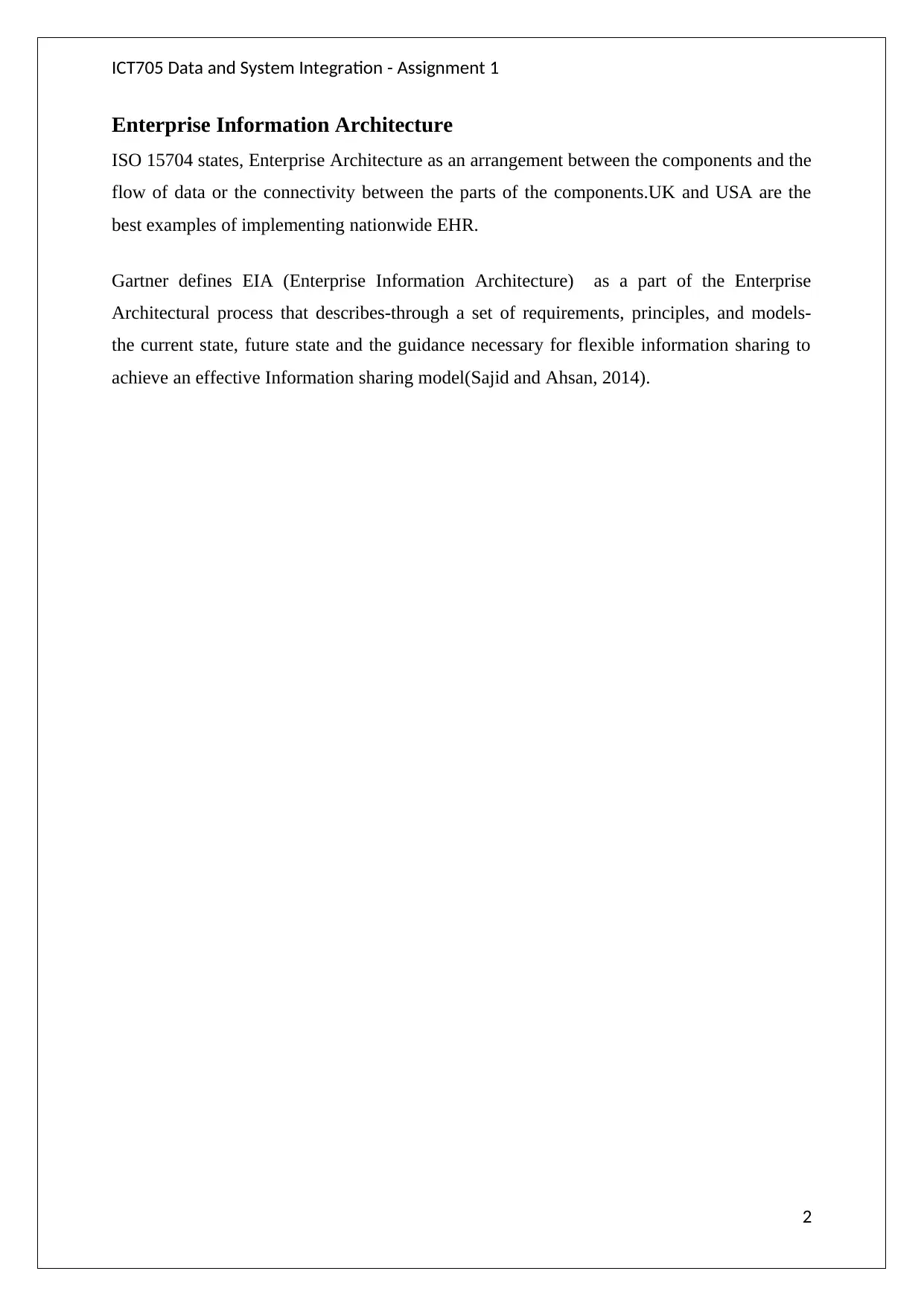
ICT705 Data and System Integration - Assignment 1
Enterprise Information Architecture
ISO 15704 states, Enterprise Architecture as an arrangement between the components and the
flow of data or the connectivity between the parts of the components.UK and USA are the
best examples of implementing nationwide EHR.
Gartner defines EIA (Enterprise Information Architecture) as a part of the Enterprise
Architectural process that describes-through a set of requirements, principles, and models-
the current state, future state and the guidance necessary for flexible information sharing to
achieve an effective Information sharing model(Sajid and Ahsan, 2014).
2
Enterprise Information Architecture
ISO 15704 states, Enterprise Architecture as an arrangement between the components and the
flow of data or the connectivity between the parts of the components.UK and USA are the
best examples of implementing nationwide EHR.
Gartner defines EIA (Enterprise Information Architecture) as a part of the Enterprise
Architectural process that describes-through a set of requirements, principles, and models-
the current state, future state and the guidance necessary for flexible information sharing to
achieve an effective Information sharing model(Sajid and Ahsan, 2014).
2

ICT705 Data and System Integration - Assignment 1
Proposed Architecture of the EHR: Below proposed Cloud or SaaS-based EHR [9] has
multiple benefits.
3
Connected via 3G/4G/WiFi/Intranet Connected via 3G/4G/WiFi/Intranet
Connected via 3G/4G/WiFi/Intranet Connected via 3G/4G/WiFi/Intranet
Central Database
Network
Interface
Middlew
are
Authentication
Server
Proposed Architecture of the EHR: Below proposed Cloud or SaaS-based EHR [9] has
multiple benefits.
3
Connected via 3G/4G/WiFi/Intranet Connected via 3G/4G/WiFi/Intranet
Connected via 3G/4G/WiFi/Intranet Connected via 3G/4G/WiFi/Intranet
Central Database
Network
Interface
Middlew
are
Authentication
Server
⊘ This is a preview!⊘
Do you want full access?
Subscribe today to unlock all pages.

Trusted by 1+ million students worldwide

ICT705 Data and System Integration - Assignment 1
In the above Cloud or SaaS (software as a Service) based Architecture, with 2 major
components- named, Cloud-Based System connected via 3G/4G/WiFi or Intranet and Health
Care Web Portal.
Cloud-Based System consists of a Central Database Server, a Network Interface including a
Middleware and an Authentication Server.
Central Database Server acts as a Unified Central Bank for all the Hospitals, Clinics and
Patients across the Nation. It is a Central Data Repository to host Electronic Medical Records
of Patient, Hospitals or clinics across the Country. This is available on Cloud, with proper
Authentication on the Authentication Server via genuine Login Credentials. Patients and
Hospitals can login into the System and collect the requested Information. The
Authentication Server checks for the login credentials against the user trying to get an access
and checks in the Local Database for the same, and accordingly GrantsAccess to the user, if
Authenticated, else the user is Denied Access (Sappagh, and Masri,2014).
Information from the Database is gathered via passing queries to an Interface (a Middleware)
to the Database and as shown on the Web Interface on to the Hospitals.
Middleware is hosted on Cloud to check for Web or Network traffic coming into the Interface
to facilitate the communication transactions between the Central Database and the Hospitals.
This Cloud-based Interface is equipped to handle queries coming in via 3G/4G, WiFi or
Intranet.
Simultaneously, it is equipped to handle multiple transactions at the same time.
Cloud-based Authentication Server handles all the Authentication and Authorization for the
queries. Any Authenticated User as per the Role Based Access Policies (RBAC) can perform
operations like Searching, Updating, Transferring the Patient Records. HIPPA, HL7
Certifications are the golden standards for the Healthcare Industry in the World.
Data Protection Act will be applied to this Cloud-Based System to protect the interest of
Patients and in turn, will maintain Data Privacy and Secure Information for them.
4
In the above Cloud or SaaS (software as a Service) based Architecture, with 2 major
components- named, Cloud-Based System connected via 3G/4G/WiFi or Intranet and Health
Care Web Portal.
Cloud-Based System consists of a Central Database Server, a Network Interface including a
Middleware and an Authentication Server.
Central Database Server acts as a Unified Central Bank for all the Hospitals, Clinics and
Patients across the Nation. It is a Central Data Repository to host Electronic Medical Records
of Patient, Hospitals or clinics across the Country. This is available on Cloud, with proper
Authentication on the Authentication Server via genuine Login Credentials. Patients and
Hospitals can login into the System and collect the requested Information. The
Authentication Server checks for the login credentials against the user trying to get an access
and checks in the Local Database for the same, and accordingly GrantsAccess to the user, if
Authenticated, else the user is Denied Access (Sappagh, and Masri,2014).
Information from the Database is gathered via passing queries to an Interface (a Middleware)
to the Database and as shown on the Web Interface on to the Hospitals.
Middleware is hosted on Cloud to check for Web or Network traffic coming into the Interface
to facilitate the communication transactions between the Central Database and the Hospitals.
This Cloud-based Interface is equipped to handle queries coming in via 3G/4G, WiFi or
Intranet.
Simultaneously, it is equipped to handle multiple transactions at the same time.
Cloud-based Authentication Server handles all the Authentication and Authorization for the
queries. Any Authenticated User as per the Role Based Access Policies (RBAC) can perform
operations like Searching, Updating, Transferring the Patient Records. HIPPA, HL7
Certifications are the golden standards for the Healthcare Industry in the World.
Data Protection Act will be applied to this Cloud-Based System to protect the interest of
Patients and in turn, will maintain Data Privacy and Secure Information for them.
4
Paraphrase This Document
Need a fresh take? Get an instant paraphrase of this document with our AI Paraphraser

ICT705 Data and System Integration - Assignment 1
Security and privacy controls or Provisions are applied for safeguarding Medical Information.
The Privacy Act 1988 of the Australian Government, provides these regulations to be
Implemented.
Health Care Web Portal will be the Front End Interface of the EHR, which would be
available to all the Hospitals, Clinics, Medical Research Labs and to the Patients, as a
Software as a Service (SaaS). The web portal will exchange messages between Hospitals and
the Middleware.
The End User (Patient) will have an Authority to share or restrict the level of Information,
that can be shared from the Database. However, the Patient will not be able to delete any
Information randomly on his own. For any changes in the Patient Statistical Records, a proper
Authorization and an Approval will be required and will not be able to change the Historical
Information from the Database, until and unless the entered Information is Incorrect(Cho and
Kim, 2010).
5
Security and privacy controls or Provisions are applied for safeguarding Medical Information.
The Privacy Act 1988 of the Australian Government, provides these regulations to be
Implemented.
Health Care Web Portal will be the Front End Interface of the EHR, which would be
available to all the Hospitals, Clinics, Medical Research Labs and to the Patients, as a
Software as a Service (SaaS). The web portal will exchange messages between Hospitals and
the Middleware.
The End User (Patient) will have an Authority to share or restrict the level of Information,
that can be shared from the Database. However, the Patient will not be able to delete any
Information randomly on his own. For any changes in the Patient Statistical Records, a proper
Authorization and an Approval will be required and will not be able to change the Historical
Information from the Database, until and unless the entered Information is Incorrect(Cho and
Kim, 2010).
5
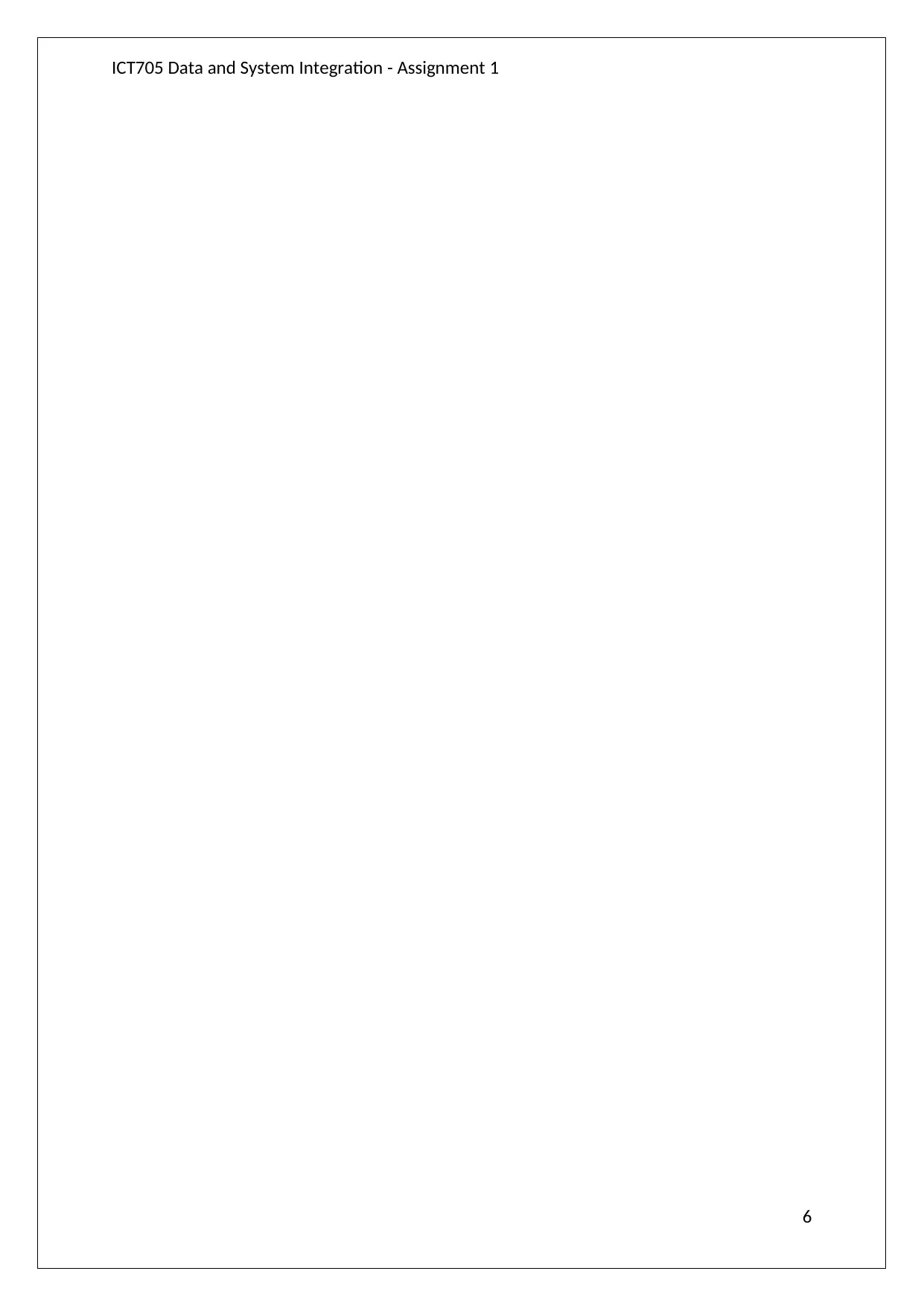
ICT705 Data and System Integration - Assignment 1
6
6
⊘ This is a preview!⊘
Do you want full access?
Subscribe today to unlock all pages.

Trusted by 1+ million students worldwide

ICT705 Data and System Integration - Assignment 1
EHR Implementation
EHR Implementation View
As demonstrated in the above EHR Implementation diagram, Users can be anyone from
Doctors to Nurses, Patients to Pharmacist for the system. The Users will be using Devices
like Tablets or Mobile Phones or Rugged Devices or Desktops or Laptops, which is used to
access SaaS or Cloud-based EHR Portal (Pessi, Magoulas and Hugoson, 2011).
Portability is one of the major requirements in this type of system, wherein, Users can access
EHR for different reasons anywhere on the go.
EHR Portal on Cloud will be in synchronization with the Application on the devices or via
the Web Page through the Browser Window. The Applications running EHR App on devices
will be transmitting the Information to the EHR Portal on Cloud. For example, Patients can
see their lab reports on the devices remotely as and when the reports are ready and pushed via
labs to the EHR portal.
7
PresentationTier(WebPortal)ApplicationTier(ApplicationServer)MiddleTier(Services)Devices (Tablets/Phones/Rugged
Devices/Desktops/Laptops)
Users (Doctors/Nurses/Pharmacist/Patients)
EHR Implementation
EHR Implementation View
As demonstrated in the above EHR Implementation diagram, Users can be anyone from
Doctors to Nurses, Patients to Pharmacist for the system. The Users will be using Devices
like Tablets or Mobile Phones or Rugged Devices or Desktops or Laptops, which is used to
access SaaS or Cloud-based EHR Portal (Pessi, Magoulas and Hugoson, 2011).
Portability is one of the major requirements in this type of system, wherein, Users can access
EHR for different reasons anywhere on the go.
EHR Portal on Cloud will be in synchronization with the Application on the devices or via
the Web Page through the Browser Window. The Applications running EHR App on devices
will be transmitting the Information to the EHR Portal on Cloud. For example, Patients can
see their lab reports on the devices remotely as and when the reports are ready and pushed via
labs to the EHR portal.
7
PresentationTier(WebPortal)ApplicationTier(ApplicationServer)MiddleTier(Services)Devices (Tablets/Phones/Rugged
Devices/Desktops/Laptops)
Users (Doctors/Nurses/Pharmacist/Patients)
Paraphrase This Document
Need a fresh take? Get an instant paraphrase of this document with our AI Paraphraser
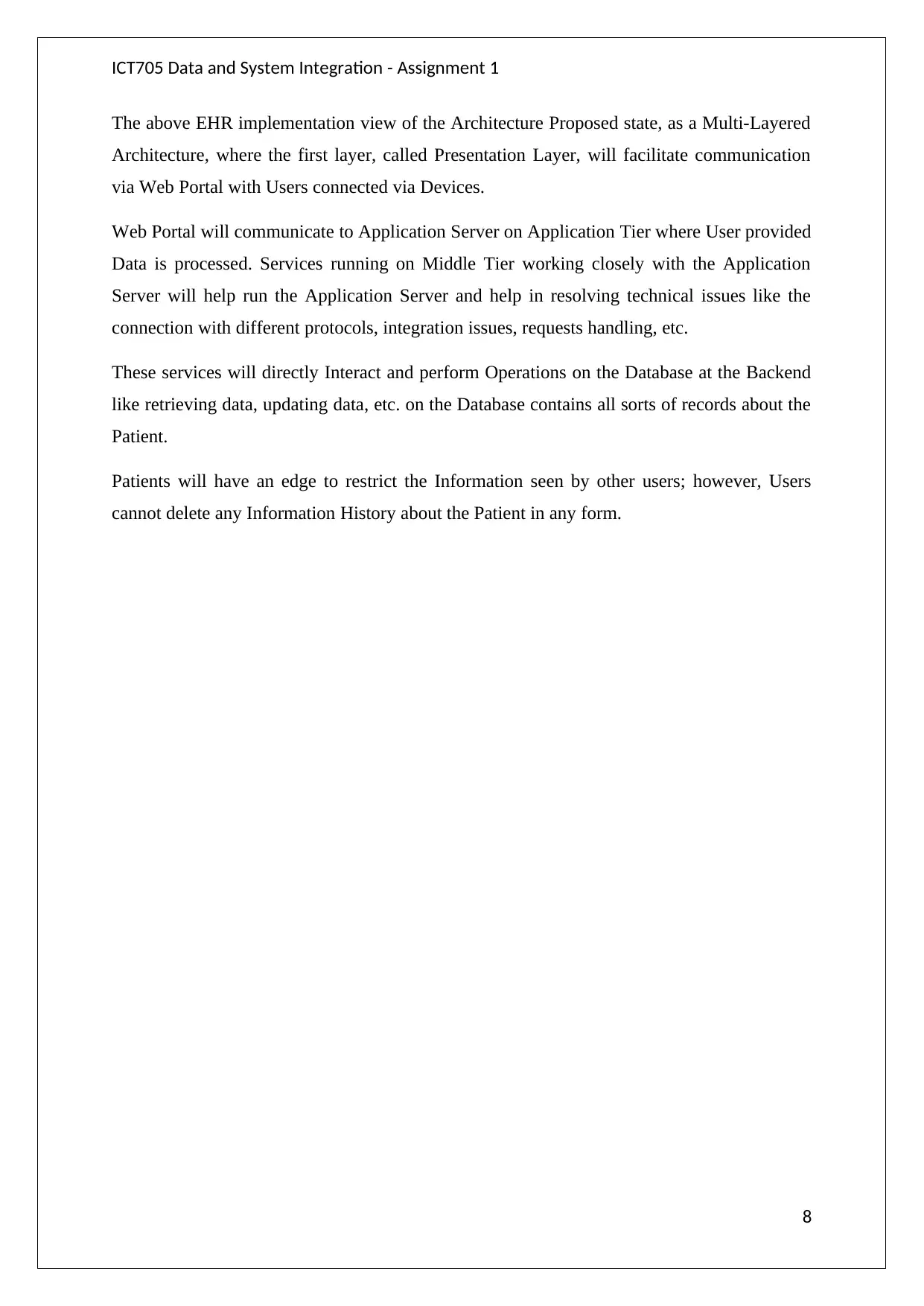
ICT705 Data and System Integration - Assignment 1
The above EHR implementation view of the Architecture Proposed state, as a Multi-Layered
Architecture, where the first layer, called Presentation Layer, will facilitate communication
via Web Portal with Users connected via Devices.
Web Portal will communicate to Application Server on Application Tier where User provided
Data is processed. Services running on Middle Tier working closely with the Application
Server will help run the Application Server and help in resolving technical issues like the
connection with different protocols, integration issues, requests handling, etc.
These services will directly Interact and perform Operations on the Database at the Backend
like retrieving data, updating data, etc. on the Database contains all sorts of records about the
Patient.
Patients will have an edge to restrict the Information seen by other users; however, Users
cannot delete any Information History about the Patient in any form.
8
The above EHR implementation view of the Architecture Proposed state, as a Multi-Layered
Architecture, where the first layer, called Presentation Layer, will facilitate communication
via Web Portal with Users connected via Devices.
Web Portal will communicate to Application Server on Application Tier where User provided
Data is processed. Services running on Middle Tier working closely with the Application
Server will help run the Application Server and help in resolving technical issues like the
connection with different protocols, integration issues, requests handling, etc.
These services will directly Interact and perform Operations on the Database at the Backend
like retrieving data, updating data, etc. on the Database contains all sorts of records about the
Patient.
Patients will have an edge to restrict the Information seen by other users; however, Users
cannot delete any Information History about the Patient in any form.
8

ICT705 Data and System Integration - Assignment 1
Various Domains where EHR has been Useful
The above diagram shows the Usage in multiple domains of implementing an EHR.
1. It enhances Patient’s care as it became easy to access Patient‘s history by Physicians
on demand and can devote quality time to the Patients.
2. Pharmaceutical companies might get involved in analyzing data from EHR.
3. Insurance Companies might request data to analyze fraud and provide insurance
policies as per the Patient’s History.
4. Public Health Department will analyze data to promote specific actions required as
per the diseases or to prevent citizens of the Country in any form.
5. Research Labs might analyze data to promote Research in a specific area.
6. Radiology or Labs will have access to upload medical reports of the Patient.
7. Ambulatory Care will be necessary if Ambulance is required to the Patient in the time
of Urgency.
8. Hospital will require access to EHR once patients visit the hospital for any
Consultancy, Surgery or for any Medical Issues.
9. Finally, EHR used by Patients to access their History for many reasons.
9
EHR
Public Health
Department
Hospital
Pharmacy
Radiology/Labs
PHR (Patient)
Ambulatory Care
Insurance
Company
Research
Primary Care
Various Domains where EHR has been Useful
The above diagram shows the Usage in multiple domains of implementing an EHR.
1. It enhances Patient’s care as it became easy to access Patient‘s history by Physicians
on demand and can devote quality time to the Patients.
2. Pharmaceutical companies might get involved in analyzing data from EHR.
3. Insurance Companies might request data to analyze fraud and provide insurance
policies as per the Patient’s History.
4. Public Health Department will analyze data to promote specific actions required as
per the diseases or to prevent citizens of the Country in any form.
5. Research Labs might analyze data to promote Research in a specific area.
6. Radiology or Labs will have access to upload medical reports of the Patient.
7. Ambulatory Care will be necessary if Ambulance is required to the Patient in the time
of Urgency.
8. Hospital will require access to EHR once patients visit the hospital for any
Consultancy, Surgery or for any Medical Issues.
9. Finally, EHR used by Patients to access their History for many reasons.
9
EHR
Public Health
Department
Hospital
Pharmacy
Radiology/Labs
PHR (Patient)
Ambulatory Care
Insurance
Company
Research
Primary Care
⊘ This is a preview!⊘
Do you want full access?
Subscribe today to unlock all pages.

Trusted by 1+ million students worldwide
1 out of 19
Related Documents
Your All-in-One AI-Powered Toolkit for Academic Success.
+13062052269
info@desklib.com
Available 24*7 on WhatsApp / Email
![[object Object]](/_next/static/media/star-bottom.7253800d.svg)
Unlock your academic potential
Copyright © 2020–2025 A2Z Services. All Rights Reserved. Developed and managed by ZUCOL.





